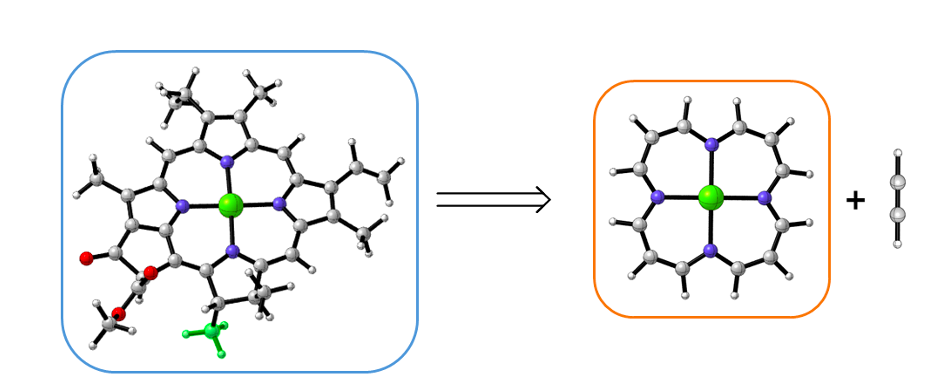- 1Centro de Astrobiología (INTA-CSIC), Instituto Nacional de Técnica Aeroespacial (INTA), Torrejón de Ardoz, 28850 Madrid, Spain (*gomezgf@cab.inta-csic.es)
- 2Atmospheric Research and Instrumentation Branch, Instituto Nacional de Técnica Aeroespacial (INTA), Torrejón de Ardoz, 28850 Madrid, Spain
- 3Instituto de Ciencias Moleculares, Universidad de Valencia, Spain
In order to determine the viability of photosynthesis in exoplanetary environments in different stellar types systems, we decided to start from the study of photosynthetic systems and the pigments that compose them and to verify their suitability in those exoplanetary environments. For this, we started from the main pigments of known photosynthesis, chlorophylls (chlorophyll a (Chla) (Figure 1) and phycocyanins as working models. We identified the need to go back to more basic pigments, with which to make the first tests to compare their spectra and their fit in the radiative systems of the different stellar types. After the first analyzes we realized that the chlorophyll systems are highly developed and we proposed the need to work with the basic molecule, porphyrin. Again, to our surprise, after successive spectroscopic analyzes once again we concluded that porphyrin were already very complex and evolved molecules. Then, we raised the need to go back in the process of molecular simplicity even further to much simpler parent molecules. In order to approach that simpler pigments we decided to theorically design the basic components which to work with.
The conjugated central ring of the Chla molecule represented in Figure 1 (Phot0) is the part which gives the spectroscopic characteristics to the whole molecule. How is the simplest system that could also be conjugated and could be a precursor of the global molecule? We should star with the central theoretical simple macrocycle (Phot0).

Figure 1. Optimized geometry of the Chla (left) and the primeval pigment Phot0 (right) at CAM-B3LYP/def2-TZVP. Note that the highlighted methyl group of the Chla should be substituted by the phytyl group on a real system. The scheme represent an hypothetical retrosynthetic analysis of Chla starting from more simple row materials (Phot0 and acetylenes).
The general idea is taking this structure as a baseline and compare its absorbance with a known photosynthetic pigment (for instance Chla).
Figure 2. UV/Vis spectrum of Chlorophyll a in diethyl ether (blue) and computed UV/Vis spectrum of the primeval theoretical pigment Phot0 computed at (TD)CAM-B3LYP/def2TZVP (orange).
Here, at the EPSC2021, we will summarize our preliminary results on the origin and evolution of theoretical and natural pigments. Basically, we can conclude that one of our simple theoretical pigment could act as a photosynthetic pigment by comparing its UV/Vis spectrum with that of the Chla. Thus, due to its characteristics, this pigment could be of great interest for anhydrous environments (e.g. Titan). The easiest way to be inert against water dissolution is to link the carbons to the nitrogen atoms less reactive. How could Nature have achieved this (on Earth)? – The answer is transforming them into a heterocycle, this is, a pyrrole. More results will be summarized in our EPSC presentation.
How to cite: García de la Concepción, J., Marcos-Arenal, P., Fonseca-Bonilla, N., Burillo-Villalobos, M., Cerdán, L., López-Cayuela, M. Á., Caballero, J. A., and Gómez, F.: Understanding the evolution of theoretically-based pigments based on their UV-Vis absorption spectra and its ability of being functional in different stellar systems., Europlanet Science Congress 2021, online, 13–24 Sep 2021, EPSC2021-787, https://doi.org/10.5194/epsc2021-787, 2021.

